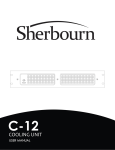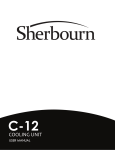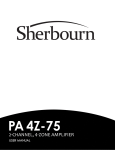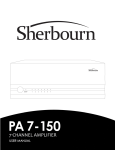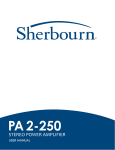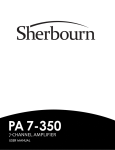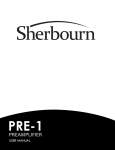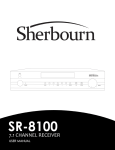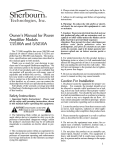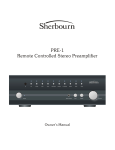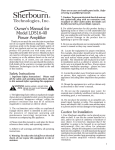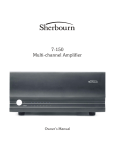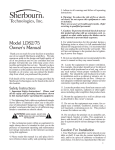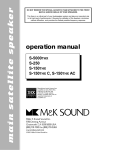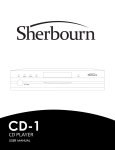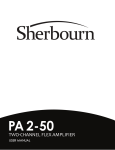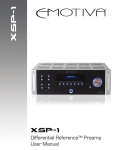Download Sherbourn Technologies PT-7030 Owner`s manual
Transcript
PA 18-45 18 CHANNEL DISTRIBUTED AUDIO AMPLIFIER Owner’s Manual Important Safety Precautions and Explanation of Symbols ! The exclamation point within an equilateral triangle is intended to alert the user to the presence of important installation, operation, and service instructions in this manual. The lightning flash with arrowhead symbol within an equilateral triangle is intended to alert the user to the presence of uninsulated dangerous voltages within the enclosure that may be of sufficient magnitude to constitute a risk of electrical shock to the user. Please read this Installation and Operation Manual thoroughly before attempting to install, configure, or operate the PA 18-45. After successful installation and configuration of the PA 18-45, be sure to retain this manual in a safe place for future reference. Safety is a key component to a long lasting and trouble free installation. Please read and follow all instructions and heed all warnings on the PA 18-45 and in this manual. The vast majority of the subsequent safety precautions are common sense. If you are not comfortable with the installation of audio/video entertainment equipment, you should seek the services of a qualified installation professional or call us for help. ! WARNING: TO REDUCE THE RISK OF FIRE OR ELECTRIC SHOCK, DO NOT USE THE PA 18-45 NEAR WATER OR IN WET LOCATIONS, DO NOT EXPOSE IT TO RAIN OR MOISTURE, DO NOT EXPOSE IT TO DRIPPING OR SPLASHING FROM OTHER SOURCES, AND ENSURE THAT NO OBJECTS FILLED WITH LIQUIDS (SUCH AS VASES) ARE PLACED ON IT. DOING SO MAY RESULT IN DAMAGE TO THE PA 18-45 AND THE RISK OF ELECTRIC SHOCK, WHICH MAY RESULT IN BODILY INJURY OR DEATH. WARNING: TO REDUCE THE RISK OF ELECTRIC SHOCK, DO NOT REMOVE THE COVER FROM THE PA 18-45. THERE ARE NO USER-SERVICEABLE PARTS INSIDE THE PA 18-45. REFER ALL SERVICE TO QUALIFIED SERVICE PERSONNEL. Do not install the PA 18-45 near or above any heat sources such as radiators, heating vents, or other apparatus that produces heat. Do not block any ventilation openings or heat sinks. Avoid installing the PA 18-45 directly above other heat-producing equipment unless sufficient ventilation or forced-air cooling is provided. Do not install the PA 18-45 in locations without proper ventilation. The PA 18-45 should not be operated on a bed, sofa, rug, or similar surface that may block vents. The PA 18-45 should not be installed in an enclosed location such as a bookcase, cabinet, or closed equipment rack unless sufficient forced-air ventilation is provided. Always install your PA 18-45 according to the manufacturer’s instructions and only use attachments or accessories specified by the manufacturer. Do not install the PA 18-45 on any stand, shelf, or other piece of furniture that is unable to support its weight. If a cart is used to move the PA 18-45, use caution to avoid injury from tip-over. Connect the PA 18-45 only to power sources of the correct voltage (as shown in this manual and on the PA 18-45). Ensure that the Input Voltage selector switch on the rear of the PA 18-45 is set to the appropriate voltage. Protect power supply cables from being pinched, walked on, or otherwise damaged. Be especially careful where the power cable enters the power outlet and the PA 18-45 unit. Only connect the PA 18-45 to an electrical outlet or extension cord of appropriate type and rating. DO NOT defeat the safety purpose of a grounding or polarized plug by removing ground pins or using unsafe adapters. A polarized plug has two blades - one wider than the other. A grounding plug has a third ground prong in addition to the two main conductors. The wide blade or third groundling prong is provided for your safety. If the provided plug does not fit your outlet, consult an electrician to replace your obsolete outlet. If you replace the PA 18-45 power cord, only use one of similar type and equal or greater current rating. The power cable for the PA 18-45 should be unplugged from the outlet during severe electrical storms, or when unused for a long period of time. Only replace the fuse in the PA 18-45 with a fuse of proper value and voltage rating. The PA 18-45 should only be cleaned as directed in the Installation and Operation Manual. Avoid spraying liquids directly onto the PA 18-45 and NEVER spray liquids into the vents. Care should be taken so that small objects do not fall into the inside of the PA 18-45. ! You should seek service for your PA 18-45 by qualified service personnel if any of the following occur: 1. The power-supply cord or the plug has been damaged. 2. Objects or liquid have fallen or spilled into the vents. 3. The PA 18-45 has been exposed to rain. 4. The PA 18-45 exhibits a marked change in performance. 5. The PA 18-45 has been dropped, or its enclosure or chassis is damaged. NOTE: TO COMPLETELY DISCONNECT THE PA 18-45 FROM THE AC POWER MAINS, DISCONNECT THE AC POWER CORD FROM THE AC RECEPTACLE. NOTE: THE PA 18-45’s AC POWER CORD MUST REMAIN READILY ACCESSIBLE AT ALL TIMES. CAUTION CAUTION: TO REDUCE THE RISK OF ELECTRICAL SHOCK, DO NOT REMOVE COVER. NO USER SERVICEABLE PARTS INSIDE. REFER SERVICING TO QUALIFIED SERVICE PERSONNEL. PA 18-45 18-Channel Distributed Audio Amplifier Contents Important Safety Precautions and Explanation of Symbols Introduction..................................................................................................2 The Sherbourn PA 18-45.............................................................................2 About This Manual.......................................................................................2 Mechanical and Environmental...................................................................3 Front Panel..................................................................................................4 Rear Panel..................................................................................................5 Inputs and Outputs......................................................................................7 Installation Tips............................................................................................8 Configuration...............................................................................................9 Performance Specifications.......................................................................12 Features....................................................................................................13 Operation...................................................................................................14 Periodic Maintenance................................................................................15 Troubleshooting.........................................................................................16 Sherbourn Technologies, LLC Ten-Year Limited Warranty........................17 Notes.........................................................................................................18 Page 1 Introduction Thank you for choosing the Sherbourn PA 18-45 18-Channel Distributed Audio Amplifier. The Sherbourn PA 18-45 combines 18 great sounding audio channels, incredible input flexibility, user-selectable AC supply voltage, and a trigger input and output - all in one convenient package. Design features like proven class A/B technology, Sherbourn’s intelligent protection system, and true commercial grade construction quality and reliability make the Sherbourn PA 18-45 an obvious choice for your distributed audio needs. The Sherbourn PA 18-45 The Sherbourn PA 18-45 provides 18 independent channels of audiophile quality, class A/B power amplification - nominally arranged into nine stereo zones. Each channel can receive signal either from one of two input buses or from its own independent input, and each has its own independent rear-panel volume preset control. Each channel pair can optionally be bridged into a single, higherpowered channel. Each of the two stereo input buses can be configured to feed as many zones as required, and also feeds a matching stereo set of output pass-through connectors. The Sherbourn PA 18-45 offers both a Trigger Input and a Trigger Output, and can also be triggered by the presence of audio signal at its inputs. Speaker connections are via full-sized five way binding posts. Power can be either 115 VAC or 230 VAC, and is via a convenient removable IEC power cord. About This Manual This manual will provide you with all the information you need to install and configure the Sherbourn PA 18-45 18-Channel Distributed Audio Amplifier to achieve its optimum potential. The manual also includes a brief summary of the features offered by the PA 18-45 and a short description of how the controls work and how to perform common operations. You may wish to record serial numbers or other purchase information on the Notes page at the back of this manual. Page 2 Mechanical and Environmental SIDE TOP 15” SHERBOURN PA 18-45 14” RACK HANDLES 3-3/8” 1/16” 17” 19” FRONT 7” 7.75” Dimensions: 17” wide x 7.75” high x 15” deep (includes feet, binding posts, no rack ears). Weight: 40 lbs / 18 kg (unboxed); 51 lbs / 23.5 kg (boxed). Rack mountable: Yes, with optional rack handles / brackets. Power requirements: 115 VAC or 230 VAC +/- 10% @ 50 / 60 Hz (selectable by rear-panel switch). Ventilation and cooling: To avoid overheating, be sure to provide adequate clearance and ventilation. Page 3 Front Panel 1 2 3 1. On / Off Button Switches (toggles) the unit between Standby and On. 2. On / Off Indicator Illuminates red for Standby; blue for On. 3. Status LEDs (one per zone) Indicate the status of each zone. Note: Each LED indicates the status of one zone. A zone is two channels in non-bridged mode, or one bridged pair of channels in bridged mode. Page 4 Rear Panel 6 7 8 BUSS INPUT ZONE 1 Ch 2 Vol Bus Ch 4 Vol BR 1 1 2 2 Line In Bus Line In Bus RIGHT LEFT Ch 6 Vol BR 1 1 2 2 Line In Bus Line In Bus RIGHT LEFT Ch 8 Vol BR 1 1 2 2 Line In Bus Line In Bus ZONE 6 Ch 9 Vol ST Ch 10 Vol BR 1 2 2 Line In Bus Line In Bus ZONE 7 Ch 11 Vol ST 1 TRIGGER OUTPUT RIGHT ZONE 5 Ch 7 Vol ST TRIGGER INPUT 2 ZONE 4 Ch 5 Vol ST 1 ZONE 3 Ch 3 Vol BR LEFT ZONE 2 Ch 1 1 2 3 4 2 RIGHT 10 BUSS OUTPUT 1 LEFT 9 Ch 12 Vol Vol ST BR 1 1 2 2 Line In Bus Line In Bus Ch 14 Vol ST 1 2 2 Line In Bus Line In Bus 2 2 Line In Bus Line In Bus Ch 17 Vol BR 1 Ch 16 Vol ST 1 ZONE 9 Ch 15 Vol BR 1 ZONE 8 Ch 13 11 Vol ST Vol BR 1 1 2 2 Line In Bus Line In Ch 18 Bus 12 ST 1 1 2 2 Line In Bus Line In Line In Line In Line In Line In Line In Line In Line In Line In Line In Line In Line In Line In Line In Line In Line In Line In Line In Line In Bridge + Bridge - Bridge + Bridge - Bridge + Bridge - Bridge + Bridge - Bridge + Bridge - Bridge + Bridge - Bridge + Bridge - Bridge + Bridge - Bridge + Bridge - 5 13 14 SPEAKER SPEAKER SPEAKER SPEAKER SPEAKER SPEAKER SPEAKER SPEAKER SPEAKER Note: For items 1 through 5 some controls are inactive in bridged mode. Please see the Configuration section for details. 1. Input Level Control (one per channel) Controls the input level for each channel. 2. Bridged / Stereo Switch (one per zone) Configures each zone as either two independent channels or one, more powerful, bridged channel. 3. Input Selector Switch (one per channel / zone) Selects the input signal which is fed to each channel. In bridged mode, the signal from the odd numbered channel of each pair is used. 4. Line Input Connector (one per channel; unbalanced) Connect your input to this when a particular channel is set to use the independent balanced input (and not an input bus). 5. Speaker Terminals (one pair per channel) Connect speakers to these five-way binding posts. When channels are used separately, each pair (top red and bottom black) are used for the speaker for one channel. When channels are bridged, the speaker is connected to the TOP TWO RED TERMINALS (as indicated) and the black terminals are unused. Page 5 6. Zone Inputs, Outputs, and Controls (separate controls for each zone) The controls in each outlined area are for one zone. Which controls are active depends on whether the particular zone is configured as independent channels or a single bridged channel. 7. Bus Inputs Line level stereo inputs for the two input buses (unbalanced). 8. Bus Outputs Passthrough outputs for each zone for daisy chaining additional equipment. 9. Power Mode Switch Determines how the PA 18-45 responds to trigger commands, and whether it is automatically activated when an audio signal is present at the input. See the Configuration section for details. 10. Trigger Input and Trigger Output The Trigger Input is used to allow other trigger-enabled equipment to switch the PA 18-45 between On and Standby. The Trigger Output is always active when the PA 18-45 is On, and is used to control other trigger-enabled equipment. 11. AC Line Fuse Holder Always replace the fuse with a time delay (slow-blow) fuse of the same value. 12. Power Switch Switches the AC mains power to the PA 18-45 On and Off. When this switch is Off, the PA 18-45 will not respond to trigger signals or manual controls. 13. Input Voltage Selector Switch Always ensure that this switch is set for the proper line voltage for your area and installation. 14. Standard IEC power inlet. The PA 18-45 can be used with either a two-wire or three-wire standard IEC power cable. Page 6 Inputs and Outputs Analog inputs: 2 bus inputs (bus 1, bus 2); each bus has one stereo pair of unbalanced (RCA) inputs. 18 individual channel inputs; each channel has one unbalanced (RCA) input . Input sensitivity (for full output into 8 Ohms): 370 mV Speaker outputs: 18 pairs of 5-way binding posts (standard red and black); one pair per channel (in bridge mode, speakers are connected to the red binding posts of both channels in the zone). Minimum recommended load impedance: Individual channels: 4 Ohms (one 4 Ohm load or two paralleled 8 Ohm loads per channel). Bridged mode: 8 Ohms minimum load per bridged channel . Trigger and control: Trigger Input (mono 1/8”), Trigger Output (mono 1/8”). Front panel controls and indicators: On / Off (large push button); toggles Standby mode. On / Off LED (1); red indicates Standby mode; blue indicates normal operation. Zone Status LEDs (9); blue indicates normal operation; flashing blue indicates a fault; (each LED indicates the status of one zone (channel pair); (Zone Status LEDs are not lit in Standby mode). Rear panel controls and indicators: Power (rocker switch); switches mains power. Input Voltage (protected slide switch); selects 115 or 230 VAC line voltage. Power Mode slide switch (Auto / On / Triggered). Bridge Mode switch (9); labelled BR / ST for Bridge / Stereo (Independent) mode; one per zone / pair of channels; configures each zone / channel pair; as either two separate output channels (Stereo) or one bridged output channel. Line In switch (18); one per channel; selects the input source for the channel; (Bus 1, Bus 2, or individual input). In bridged mode, only one input is active per bridged pair of channels. Volume (18); sets input level / gain for each channel. In bridged mode, only one Volume control is active per bridged pair of channels; (the input and controls from the odd numbered channel are active). AC power input: IEC C17/C18 (10/15A two wire) type inlet and power cord. AC Power line fuse (rear panel holder). Page 7 Installation Tips Input Buses and Individual Inputs The system of input buses and individual inputs on the PA 18-45 offers an amazing amount of flexibility. The PA 18-45 can be treated as: • • • • 18 separate channels, each with an individual input and level / gain control. 9 zones (stereo pairs of channels), each pair deriving its input either from individual inputs or from one of two stereo buses, and each channel with an individual level / gain control. 9 high-powered channels, each deriving its input from either an individual input or a bus, and each with an individual level / gain control. Even more creative and complex configurations are possible with a little planning. Note: Remember that the buses feed the channels as stereo pairs, so the odd numbered channels (CH1, CH3, CH5, CH7, CH9, CH11, CH13, CH15, CH17) are fed by the Right input from the bus, while the even numbered channels (CH2, CH4, CH6, CH8, CH10, CH12, CH14, CH16, CH18) are fed by the Left input from the bus. When a pair of channels is in Bridged mode, and it is configured to receive its input from Bus 1 or Bus 2, it receives its signal from the Right input of that bus. When a pair of channels is in Bridged mode, and is not configured to receive its input from a bus, the Input, Input Selector switch, and Volume control on the odd numbered channel input of the pair are active and those on the even numbered channel input are ignored. Ventilation and cooling Even though the PA 18-45 is quite efficient, it still produces significant heat; to avoid overheating, be sure to provide adequate clearance and ventilation. Overheating adversely affects performance and shortens component life. We suggest locating components that produce the most heat towards the top of your rack if practical, and leaving at least 1U (1.75”) of rack space between components. Space between components can be left open for ventilation, filled with a spacer, or used to house a forced-air cooling solution. Sherbourn’s C-12 Flex Rack™ Cooling System uses whisper quiet high capacity variable speed fans to provide over 100 CFM of forced air cooling for rack installations. The C-12 offers a variety of air-flow options (including external ducting), includes professional features like triggered operation and thermostatic control, and takes up only 2U of rack space. Page 8 Configuration Operating Voltage - Verify that the Sherbourn PA 18-45 is configured for the correct operating voltage for your area. (Voltage is set via the Input Voltage switch on the rear panel of the PA 18-45). Power Mode - The way in which the PA 18-45 responds to the Trigger Input, audio signals, and the front panel On / Off switch is determined by the setting of the Power Mode switch (the small slide switch on the rear panel next to the Trigger In and Trigger Out connectors). The Trigger Output on the PA 18-45 is controlled only by the status of the PA 18-45, and will be active (high) whenever the PA 18-45 is On (and not in Standby mode). When the rear panel Power rocker switch is set to Off, the PA 18-45 is powered completely off and will not respond to any other control, switch setting, or input (and the Trigger Output will be off). In order for the PA 18-45 to operate as described below, the rear panel Power rocker switch must be set to On. • When the Power Mode switch is set to On, the PA 18-45 is controlled by the front panel On / Off switch, which toggles between Standby mode and On each time it is pressed. • When the Power Mode switch is set to Auto, the PA 18-45 is controlled by audio input; the PA 18-45 switches On when there is audio signal present at any of the inputs (this will occur even when audio arrives at an input which is not assigned to any channel as a source); the PA 18-45 will return to Standby mode about fifteen minutes after audio input signal is no longer present. • When the Power Mode is set to Trigger, the PA 18-45 will switch On when a Trigger signal is received, and will return to Standby mode when the Trigger signal is no longer present. Note: Always switch the PA 18-45 Off and then back On using the REAR PANEL POWER SWITCH after changing the setting of the Power Mode switch. Zone and Input Configuration - The PA 18-45 is arranged as nine zones, with two channels in each zone. The two channels in each zone may optionally be bridged into a single, high-powered, channel. The Bridge / Stereo selector switch (BR / ST) for each zone determines whether that zone acts as two independent channels or a single bridged channel. Note: Speakers must be connected differently depending on which way the Bridge / Stereo switch is set. Please ensure that both the Bridge / Stereo switch setting and the wiring configuration of your speakers for each channel are correct and consistent before turning on the PA 18-45. Failure to do so may result in unexpected behavior and possible damage to the PA 18-45. Bus Inputs and Outputs - The PA 18-45 has two stereo Input Buses - Bus 1 and Bus 2. BUS INPUT 1 2 If one or both channels in a zone are configured to use a particular bus as an input source, then the appropriate input signal is LEFT RIGHT LEFT RIGHT routed to that channel (odd numbered channels receive the Right bus input; even numbered channels receive the Left bus input). If the zone is configured as Bridged, then the Right Input for that bus is used as the signal source for the bridged channel and the Left Input signal is ignored. When the PA 18-45 is On, the signal present at each Bus Input connector is buffered and is available at the corresponding Bus Output connector. Page 9 Configuring a Stereo or Independent Channel Zone - Independent channels may be connected to a minimum load impedance of 4 Ohms. To configure the two channels in a zone as a stereo pair, or as independent channels, set the Bridge / Stereo switch to ST and connect one speaker to each of the left and right pairs of binding posts (as shown below). With the zone configured this way, each amplifier is independent, and is controlled by its own separate Volume control. The Input Selector switch (also independent for each channel) is used to select an input source for that channel. If Line In is selected, then the unbalanced (RCA) input jack directly below the switch is used as the signal source for that channel. If Bus 1 or Bus 2 is selected, then the selected Input Bus is used as the signal source. Note: The channel inputs assume a stereo relationship between the channels and the input buses. When a given bus is selected as the source for a particular channel, odd numbered channels will receive input from the Right Input for the chosen bus and even numbered channels will receive input from the Left Input for the chosen bus. That way, if you select a certain bus as the source for both channels in a zone, the two channels in that zone will provide a stereo output that corresponds to the stereo input signal on the chosen bus. In the figure below, with the switches set as shown, and a stereo source connected to Input Bus 2, the speakers will be playing the signal from Input Bus 2, in stereo, with the right channel on Channel 5 and the left channel on Channel 6. ZONE 3 Ch 5 Ch 6 Vol Vol BR Bus ST 1 1 2 2 Line In Bus Line In Line In Line In Bridge + Bridge - + + SPEAKER Note: Since the input for each channel can be chosen independently, it is possible to create configurations where inputs other than stereo pairs are connected to the “left” and “right” inputs of one bus, and are routed independently to various amplifier channels. If this is not your express intent, and you are using stereo inputs and outputs, then be sure to set BOTH Input Selector switches on each zone to the same source when using stereo buses. Page 10 Configuring a Bridged Zone - Bridged channels may be connected to a minimum load impedance of 8 Ohms. To configure the two channels in a zone as a Bridged channel, set the Bridge / Stereo switch to BR and connect one speaker to the TWO RED BINDING POSTS (as shown below). Note: The polarity markings that pertain to Bridged mode are the small “Bridge +” and “Bridge -” marked next to the two red binding posts. In Bridged mode, ignore the polarity markings located between the left and right sets of binding posts. In Bridged mode, the two black binding posts remain UNUSED. With the zone configured this way, the zone acts as a single amplifier channel, with much more power than each individual channel. The shaded background shows which controls and connectors are active in Bridged mode (the controls from the odd numbered channel are active in this configuration, and those in the even numbered channel are ignored.) The Volume control from the odd numbered channel is used to control gain, and the Input Selector switch from that channel is used to select the input source. If Line In is selected, then the unbalanced (RCA) input jack directly below the active (odd numbered channel) switch is used as the signal source for that channel. If Bus 1 or Bus 2 is selected, then the RIGHT input for the selected bus is used as the source of input. Note: Remember that, in Bridged mode, the “Right channel” (odd numbered channel) controls and inputs are active (note the shading on the panel) and the Left channel inputs and controls are ignored. In the figure below, with the switches set as shown, and a stereo source connected to Input Bus 1, the speaker will be playing the signal from the Right channel of Input Bus 1. (The Volume and Input Selector switch settings on Channel 6 don’t matter; they are ignored.) ZONE 3 Ch 5 Ch 6 Vol Vol BR Bus ST 1 1 2 2 Line In Bus Line In Line In Line In Bridge + Bridge - + SPEAKER Page 11 Performance Specifications Analog inputs: 2 bus inputs (Bus 1, Bus 2); each bus has one stereo pair of unbalanced (RCA) inputs. 18 individual channel inputs; each channel has one unbalanced (RCA) input. Analog outputs: 2 bus outputs (Bus 1, Bus 2); each bus has one stereo pair of unbalanced (RCA) outputs which provide a buffered copy of the input signal. Input sensitivity (for full output): 370 mV (8 ohm load). Speaker outputs: 18 pairs of 5-way binding posts (standard red and black); one pair per channel; (in bridge mode, speakers are connected to the red binding posts of both channels in the zone). Minimum recommended load impedance: Individual channels; 4 Ohms (which equals one 4 Ohm load or two paralleled 8 Ohm loads). Bridged channels; 8 Ohms. Power output (per channel): 45 watts RMS per channel (x18); into 8 Ohms; two channels driven. 70 watts RMS per channel (x18); into 4 Ohms; two channels driven. 40 watts RMS per channel (x18); into 8 Ohms; six channels driven. 140 watts RMS per channel (x9); into 8 Ohms (bridged) . S/N ratio: > 100 dB (A-weighted). Frequency response: 20 Hz to 20 kHz + / - 0.1 dB at 1 watt (-3 dB at 80 kHz). Trigger and control: Trigger Input: 3 - 30 V AC or DC. Trigger Output: 12 V DC 10 mA max. Protection: The Sherbourn PA 18-45 is protected against excessive operating temperature, shorted speaker connections, ground faults, and other common fault conditions. If a fault occurs, the PA 18-45 will automatically power down and the front panel status LEDs will indicate the faulty channel(s). Each channel status indicator shows the status of one zone (a zone is a pair of channels). If a channel experiences a short or other fault, both channels in that zone (but not the other zones) will go into protect mode and shut down; the channel status LED for the zone in protect mode will turn FLASHING blue. To reset the protection, turn the PA 18-45 Off and then On again using the REAR PANEL POWER SWITCH after the fault has been removed. Page 12 Features The Sherbourn PA 18-45 18-Channel Distributed Audio Amplifier combines the latest cutting edge technology with solid engineering and high quality components to deliver superior sound quality, performance, and features. Some of the more important features of the PA 18-45 include: • • • • • • • • • • • • • 18 channels of fully discrete, audiophile quality, sound. Each channel delivers: 45 watts into 8 Ohms. 70 watts into 4 Ohms. 140 watts into 8 Ohms (9 channels / bridged mode). Two stereo input buses and individual channel insert points. Always-on, auto-sense, and triggered power modes. Convection cooled, with fan assist. Massive toroidal power supply. Full sized five way binding posts. Front panel zone status indicators. Intelligent protection from electrical faults. Intelligent protection from thermal faults and overheating. Independent zone fault protection allows other zones to continue operating after one or more zones have entered protect mode and shut down. Rack mountable. 10 year Sherbourn Technologies Limited Warranty. You can find more information about the PA 18-45 18-Channel Distributed Audio Amplifier on our website at www.sherbourn.com. Page 13 Operation Turning on the AC power The AC mains power on the PA 18-45 is controlled by the Power rocker switch located on the rear panel above the power cable. Once the AC power is turned on, the PA 18-45 will remain in Standby mode until the Power On / Off push button on the front panel is pressed, the Trigger Input is asserted, or an audio signal is received at an input (depending on how the Power Mode switch is configured). The Power Mode switch is the small slide switch on the lower left corner of the rear panel labelled “On/Auto/Trigger”. Note: Always switch the PA 18-45 Off and then back On using the REAR PANEL POWER SWITCH after changing the setting on the Power Mode switch. Status Indicators When the PA 18-45 is in Standby mode, the single LED next to the front panel On/Off switch (the On/Off LED) will be lit red; when the PA 18-45 is On, the On/Off LED and the nine channel status LEDs will be lit blue (a blue flashing zone status LED indicates a fault). Operating the Sherbourn PA 18-45 Manually When the Power Mode switch is set to “On”, the PA 18-45 is controlled by the front panel On/Off button. Press the On/Off button once to turn the PA 18-45 On and again to return it to Standby. Operating the Sherbourn PA 18-45 in Trigger Mode When the PA 18-45 is in Standby mode, asserting a trigger signal turns it On, and it remains On until the trigger is no longer asserted. If the trigger signal is already active when mains power is applied, the PA 18-45 will switch On as soon as it completes self-test, and will switch to Standby when the trigger is no longer asserted. If the front panel On / Off switch is pressed while the PA 18-45 is On (after being switched on by an asserted trigger), the On / Off switch WILL override the trigger and the PA 18-45 will return to Standby position (even though the trigger is still being asserted). Pressing the front panel On / Off button, dropping and re-asserting the trigger, or switching the mains power off and on again while the trigger remains asserted, will then switch the unit back to On. Operating the Sherbourn PA 18-45 in Auto Mode When the Power Mode is set to “Auto”, the PA 18-45 is controlled by the presence of audio signal at ANY input. The PA 18-45 will switch On immediately when an audio signal is detected at any input, and will return to Standby mode approximately fifteen minutes after audio is no longer present at any input. Note: Pressing the front panel On/Off button when the PA 18-45 is in Trigger or Auto mode and is On will manually override the trigger signal and switch the PA 18-45 Off. Page 14 Resetting a fault If a channel experiences a short or other fault, both channels in that zone (but not the other zones) will go into protect mode and shut down and the zone status LED for that zone will turn FLASHING blue. The main Power LED and the other channel status LEDs will remain blue, and the other zones will remain in operation. To reset the protection, turn the PA 18-45 Off and then On again using the REAR PANEL POWER SWITCH after the fault has been removed. If the fault indication remains, please refer to the Troubleshooting section for more options. Periodic Maintenance The Sherbourn PA 18-45 requires no periodic maintenance. Cleaning the Sherbourn PA 18-45 • • If necessary, the Sherbourn PA 18-45 should be cleaned gently with a soft rag. If something sticky gets on the front panel or case of the PA 18-45, it should be cleaned with a mild cleaning solution applied to a soft rag, followed by wiping with a clean rag dampened with plain water and drying with a soft dry rag or cloth. Note: DO NOT spray water or cleaning solution directly onto the Sherbourn PA 18-45 or into the vents. Page 15 Troubleshooting If problems occur, the first step should be to verify that the PA 18-45 is set to the proper line voltage for your AC power source, and that your power source is operating correctly. Problem: No sound is heard from any channel (the On/Off LED is not lit). Reason: You have no AC power. • Verify that the circuit is live and the rear panel Power switch is On. • Verify that the line cord on the PA 18-45 is fully inserted and is tight. Problem: No sound is heard from any channel (the On/Off LED is lit red). Reason: The PA 18-45 is in Standby mode. • If the PA 18-45 is in “On” power mode, press the On / Off button. • If the PA 18-45 is in “Trigger” power mode, verify that a trigger signal is present. • If the PA 18-45 is in “Auto” power mode, verify that audio signal is present at an input. • If the PA 18-45 is in “Auto” or “Trigger” mode, yet fails to respond to an appropriate trigger input, it may be in the manual override mode; switch the power Off and back On (using the REAR PANEL power rocker switch) to clear the override. Problem: No sound or distorted sound is heard from one or more channels (the Power LED and all channel status LEDs are lit blue). Reason: The PA 18-45 is On and is not indicating a fault. • Verify that the input configuration for that channel is correct. • Check the Bridge / Stereo switch that controls the pair of channels involved. • Verify that the Volume for that channel is not set all the way down. • Check your source and your input cabling. • Check your speakers and speaker connections. Problem: No sound is heard from one or more channels (one or more channel status LEDs are FLASHING blue). Reason: The PA 18-45 is indicating a fault on one or more channels (the flashing LEDs correspond to the zone where a fault has been detected). A fault with either channel in a zone will result in a fault for that zone; in Stereo / Separate Mode BOTH channels in that zone (only) will be disabled. • • • • Verify that the speaker cable(s) and speaker terminals are not shorted. Verify that the speaker itself is not shorted or damaged (try the speaker on another channel and see if the fault “moves”). Verify that the source is not faulty (try that input cable on another input and see if the fault “moves”). Disconnect all inputs and outputs and reset the PA 18-45 (turn the rear panel Power rocker switch Off and back On). If the fault condition persists after all inputs and outputs have been disconnected and the fault has been reset, and the Voltage Select switch is in the proper position, please contact Sherbourn Technical Support. Page 16 Sherbourn Technologies, LLC Ten-Year Limited Warranty What does this warranty cover? Sherbourn Technologies, LLC (“Sherbourn”) warrants its products against defects in materials and workmanship. This warranty is subject to revision at any time. How long does this coverage last? This warranty commences on the date of retail purchase by the original retail purchaser and runs for a period of ten (10) years thereafter, with the following exceptions: (1) receivers (including the SR-8100, SR-8200, and SR-120), preamp/processors (including the PT-7030, PT-720C4, and PT-7020), preamplifiers (including the PRE-1), and the CD-1 CD Player (with the exception of the slot load CD engine) are covered by this warranty for five (5) years from the date of retail purchase by the original purchaser; and (2) electromechanical components, including the slot load CD engine on the CD-1 CD Player, and all fans (including the C-12 Cooling Unit), are covered by this warranty for three (3) years from the date of retail purchase by the original retail purchaser. This warranty is transferrable, upon written notification to Sherbourn, to any person that owns the warranted product, however, if ownership is transferred, the Term shall be no longer than five (5) years from the date of purchase by the original purchaser. Sherbourn warrants any replacement product or part furnished hereunder against defects in materials and workmanship for the longer of the following: (i) the amount of time remaining under the original warranty, or (ii) 120 days from your receipt of the repaired or replaced product. The duration described in the previous 3 sentences is hereinafter referred to as the “Term”. TO THE FULLEST EXTENT PERMITTED BY LAW, ALL IMPLIED WARRANTIES RELATED TO THE ORIGINAL PRODUCT AND ANY REPLACEMENT PRODUCT OR PARTS (INCLUDING IMPLIED WARRANTIES OF MERCHANTABILITY AND FITNESS FOR A PARTICULAR PURPOSE) ARE EXPRESSLY LIMITED TO THE TERM OF THIS LIMITED WARRANTY. SOME STATES DO NOT ALLOW LIMITATIONS ON HOW LONG AN IMPLIED WARRANTY LASTS, SO THE ABOVE LIMITATION MAY NOT APPLY TO YOU. A claim under this warranty must be made by you within the Term. A claim shall not be valid (and Sherbourn has no obligation related to the claim) if it is not made within the Term and if it is not made in strict compliance with the requirements of the “How do you get service?” section. What will Sherbourn do? Sherbourn will, at its option, either: (i) repair the product, or (ii) replace the product with a new consumer product which is identical or reasonably equivalent to the product. Sherbourn may provide you with a refund of the actual purchase price of the product in the event (i) Sherbourn is unable to provide replacement and repair is not commercially practicable or cannot be timely made, or (ii) you agree to accept a refund in lieu of other remedies hereunder. When a product or part is repaired or replaced, any replacement item becomes your property and the replaced item becomes Sherbourn’s property. When a refund is given, the product for which the refund is provided must be returned to Sherbourn and becomes Sherbourn’s property. What is not covered by this warranty? This warranty does not apply: (i) to damage caused by use with non-Sherbourn products, where the non-Sherbourn product is the cause of the damage; (ii) to damage caused by service or maintenance performed by anyone who is not a representative of Sherbourn; (iii) to damage caused by accident, abuse, misuse, flood, fire, earthquake or other external causes; (iv) to a product or part that has been modified after its retail purchase, where the modification caused or contributed to the damage; (v) to consumable parts, such as batteries; (vi) normal wear tear; or (vii) if any Sherbourn serial number has been removed or defaced and Sherbourn cannot otherwise confirm that you are the original retail purchaser or authorized transferee. SHERBOURN SHALL NOT BE LIABLE FOR ANY INCIDENTAL OR CONSEQUENTIAL Page 17 DAMAGES ARISING FROM OR RELATED TO ANY DEFECTS IN OR DAMAGES TO ITS PRODUCTS. SOME STATES DO NOT ALLOW THE EXCLUSION OR LIMITATION OF INCIDENTAL OR CONSEQUENTIAL DAMAGES, SO THE ABOVE LIMITATION OR EXCLUSION MAY NOT APPLY. How do you get service? In order to make a claim under the warranty, you must: 1. Call a customer service representative (“CSR”) of Sherbourn at (1-877-366-8324). Provide the CSR with a description of your problem and the serial number of the product for which the warranty claim is being made. 2. The CSR will provide you with a returned material authorization number (“RMA”). 3. Ship the product to Sherbourn at the following address, with the RMA written in large, bold letters on the outside of the box, and with the letters “RMA” written before the number. Parcels arriving without a RMA number on the outside of the box will be refused. Sherbourn Technologies, LLC Attn: Repair Department 131 Southeast Parkway Court Franklin, TN 37064 How does state law apply? This warranty gives you specific legal rights, and you may also have other rights which vary from state to state. CERTAIN STATES HAVE ENACTED LAWS WHICH PRECLUDE THE WAIVER OF CONSEQUENTIAL AND INCIDENTAL DAMAGES AND/ OR PRECLUDE THE WAIVER/LIMITATION OF IMPLIED WARRANTIES. TO THE EXTENT YOUR STATE HAS ENACTED A LAW WHICH PROHIBITS SUCH A WAIVER/LIMITATION, ALL SUCH WAIVERS/LIMITATIONS CONTAINED IN THIS WARRANTY ARE INAPPLICABLE TO YOU. CERTAIN STATES HAVE ENACTED LAWS WHICH REQUIRE THE DURATION OF A WARRANTY TO BE EXTENDED (INCLUDING BUT NOT LIMITED TO DURING PERIODS OF REPAIR). TO THE EXTENT YOUR STATE HAS ENACTED A LAW OF THIS NATURE, THEN THE DURATION OF THIS WARRANTY WILL BE EXTENDED AS REQUIRED BY APPLICABLE LAW. Notes All information contained in this manual is accurate to the best of our knowledge at the time of publication. In keeping with our policy of product improvement, we reserve the right to make changes to the design and features of our products without prior notice. User Manual Revision 1.1 Page 18 Feb 2013























